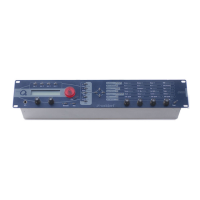Sound Parameters – Overview of Functions
45 Waldorf microQ User´s Manual
Sound Parameters
Overview of Functions
The Waldorf microQ consists of numerous sound-shaping components. The following overview gives
you an idea of how the individual components interact:
Output
R
L
Audio Signal
Controller Signal
Sync
FM Destination
Oscillator 1
…
Oscillator 3
…
External Audio
Signal
Noise Generator
Filter 1
…
Filter 2
…
Routing
Oscillator 2
…
Pan 2
Ring Modulator
Pan 1
Amplifier
FX1 / FX 2
Modifiers
f(x, y)
Modulation
Matrix
Filter Envelope
Amplifier
Envelope
Envelope 3 Envelope 4LFO 3
…
LFO 2
…
LFO 1
…
Arpeggiator
Trigger
MIDI Clock
MIDI Input
Mixer
Picture 6: Block schematic diagram of a sound
As you can see, the microQ consists of two different types of components for sound generation and
sound shaping:
• Oscillators, Ring Modulator, Noise Generator, External Audio Signal, Mixer, Filters,
Amplifier, Effects:
These modules represent the audio signal flow. Sound generation actually occurs within
the Oscillators. They produce square, sawtooth, triangular, sine and alternative waveforms.
The Mixer follows the Oscillators in the signal chain, which is where the Oscillators’
output signals are mixed. Noise or signals received through the audio inputs can also be
added to the mix. The Filter then shapes the sound by amplifying (boosting) or attenuating
(dampening) certain frequencies. The Amplifier and the Effects are located at the end of the
signal chain. They determine the overall volume of the signal and add some effects like
chorus, flanger, delay etc.
• LFOs, Envelopes, Modifiers, Modulation Matrix:
These modules are called Modulators. The Modulators are designed to manipulate or
modulate the sound generating components to add dynamics to sounds. The Low-
frequency Oscillators (LFO) are designed for periodic or recurring modulations while
Envelopes are for modulations that occur once on each note. These generators are

